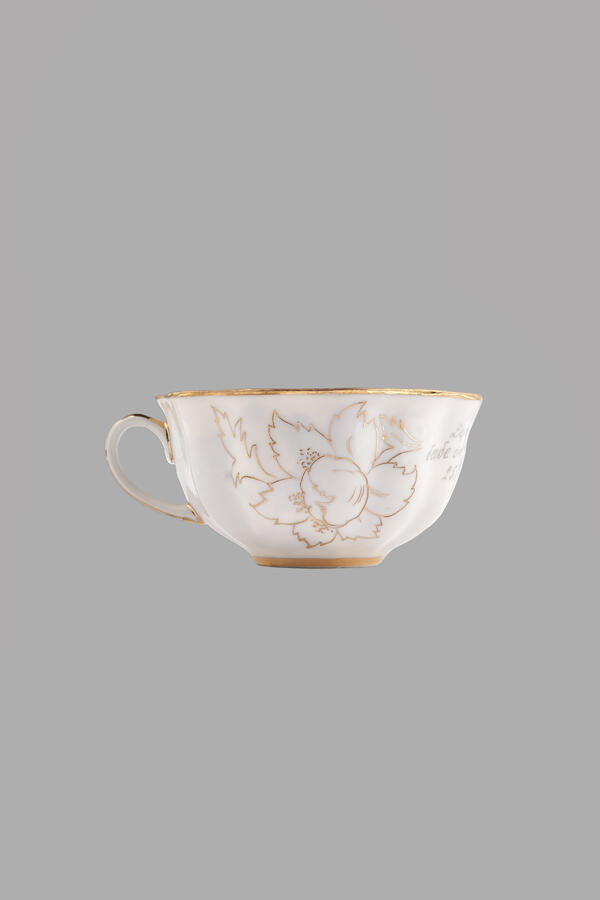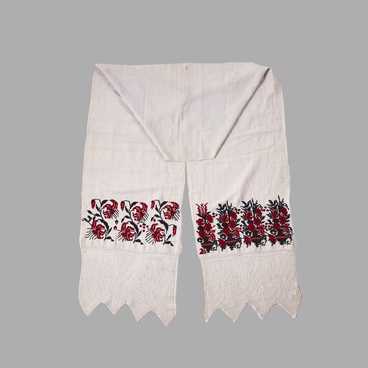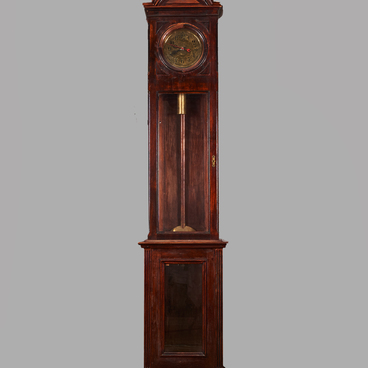The tea cup, displayed in the museum’s permanent exhibition, belonged to the family of the Soviet writer Fyodor Vasilyevich Gladkov. The cup is presented in the interior of the “Living room of Fyodor Vasilyevich Gladkov”. His name is connected with Novorossiysk. Fyodor Gladkov wrote the novel “Cement”, dedicated to the restoration of the cement industry, which made him famous throughout the country. The novel reflected Gladkov’s impressions of Novorossiysk, where he repeatedly lived.
This is a rounded tea cup on a ring leg, with a vertical convex relief on the body. The rim is wavy, the inside is painted with blue flowers and gold, the contours of flowers are painted with gold on the outside, as well as the handle. The tea cup was made by the porcelain artist Ivan Grigorievich Konkov and produced at the Dulyovo Porcelain Factory.
The Dulyovo Porcelain Factory was founded in 1832, when the merchant Terenty Kuznetsov acquired the land of the Dulyovo wasteland near the village of Likino and built a porcelain factory there. Later, the city of Likino-Dulyovo appeared there. At the end of the 19th century, the factory was a member of the “Partnership for the Production of Porcelain and Faience Products of M.S. Kuznetsov”. Kuznetsov became a faience magnate, a supplier to the imperial court. The Dulyovo factory was one of the most successful enterprises of the partnership. The products of the Dulyovo factory were valued in Russia and around the world.
The secret of the worldwide success lay in the talent of craftsmen and artists, as well as in a special way of processing materials and fuel quality. To make clay especially malleable, it was kept in cellars for a year, which was called “letovanie” (which can be loosely translated as “summering”). Peat was collected only until July 20, since the later one did not dry out by the time of use.
During the Soviet period, the Dulyovo factory was nationalized and remained one of the best enterprises in the industry. Back then many factory artisans received awards at world exhibitions, including the artist Ivan Grigorievich Konkov. After 1991, the Dulyovo factory had financial difficulties, and in 2012, the factory was sold to Russian entrepreneurs. Now it is a completely modernized enterprise.
This is a rounded tea cup on a ring leg, with a vertical convex relief on the body. The rim is wavy, the inside is painted with blue flowers and gold, the contours of flowers are painted with gold on the outside, as well as the handle. The tea cup was made by the porcelain artist Ivan Grigorievich Konkov and produced at the Dulyovo Porcelain Factory.
The Dulyovo Porcelain Factory was founded in 1832, when the merchant Terenty Kuznetsov acquired the land of the Dulyovo wasteland near the village of Likino and built a porcelain factory there. Later, the city of Likino-Dulyovo appeared there. At the end of the 19th century, the factory was a member of the “Partnership for the Production of Porcelain and Faience Products of M.S. Kuznetsov”. Kuznetsov became a faience magnate, a supplier to the imperial court. The Dulyovo factory was one of the most successful enterprises of the partnership. The products of the Dulyovo factory were valued in Russia and around the world.
The secret of the worldwide success lay in the talent of craftsmen and artists, as well as in a special way of processing materials and fuel quality. To make clay especially malleable, it was kept in cellars for a year, which was called “letovanie” (which can be loosely translated as “summering”). Peat was collected only until July 20, since the later one did not dry out by the time of use.
During the Soviet period, the Dulyovo factory was nationalized and remained one of the best enterprises in the industry. Back then many factory artisans received awards at world exhibitions, including the artist Ivan Grigorievich Konkov. After 1991, the Dulyovo factory had financial difficulties, and in 2012, the factory was sold to Russian entrepreneurs. Now it is a completely modernized enterprise.





